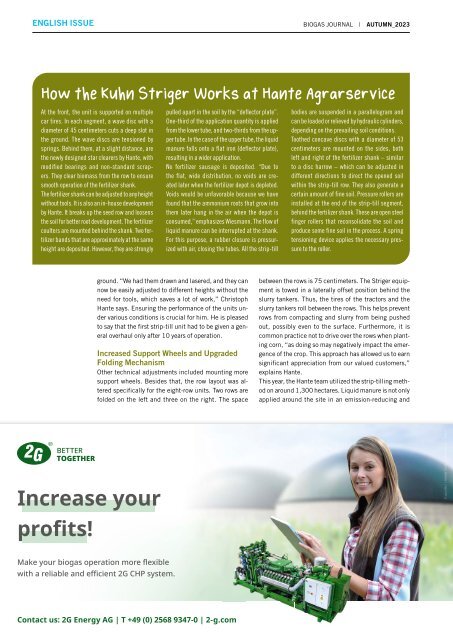Autumn 2023 EN
The German Biogas Association presents its autumn 2023 issue of the English BIOGAS journal.
The German Biogas Association presents its autumn 2023 issue of the English BIOGAS journal.
- No tags were found...
You also want an ePaper? Increase the reach of your titles
YUMPU automatically turns print PDFs into web optimized ePapers that Google loves.
<strong>EN</strong>GLISH ISSUE<br />
BIOGAS JOURNAL | AUTUMN_<strong>2023</strong><br />
How the Kuhn Striger Works at Hante Agrarservice<br />
At the front, the unit is supported on multiple<br />
car tires. In each segment, a wave disc with a<br />
diameter of 45 centimeters cuts a deep slot in<br />
the ground. The wave discs are tensioned by<br />
springs. Behind them, at a slight distance, are<br />
the newly designed star clearers by Hante, with<br />
modified bearings and non-standard scrapers.<br />
They clear biomass from the row to ensure<br />
smooth operation of the fertilizer shank.<br />
The fertilizer shank can be adjusted to any height<br />
without tools. It is also an in-house development<br />
by Hante. It breaks up the seed row and loosens<br />
the soil for better root development. The fertilizer<br />
coulters are mounted behind the shank. Two fertilizer<br />
bands that are approximately at the same<br />
height are deposited. However, they are strongly<br />
pulled apart in the soil by the “deflector plate”.<br />
One-third of the application quantity is applied<br />
from the lower tube, and two-thirds from the upper<br />
tube. In the case of the upper tube, the liquid<br />
manure falls onto a flat iron (deflector plate),<br />
resulting in a wider application.<br />
No fertilizer sausage is deposited. “Due to<br />
the flat, wide distribution, no voids are created<br />
later when the fertilizer depot is depleted.<br />
Voids would be unfavorable because we have<br />
found that the ammonium roots that grow into<br />
them later hang in the air when the depot is<br />
consumed,” emphasizes Wiesmann. The flow of<br />
liquid manure can be interrupted at the shank.<br />
For this purpose, a rubber closure is pressurized<br />
with air, closing the tubes. All the strip-till<br />
bodies are suspended in a parallelogram and<br />
can be loaded or relieved by hydraulic cylinders,<br />
depending on the prevailing soil conditions.<br />
Toothed concave discs with a diameter of 53<br />
centimeters are mounted on the sides, both<br />
left and right of the fertilizer shank – similar<br />
to a disc harrow – which can be adjusted in<br />
different directions to direct the opened soil<br />
within the strip-till row. They also generate a<br />
certain amount of fine soil. Pressure rollers are<br />
installed at the end of the strip-till segment,<br />
behind the fertilizer shank. These are open steel<br />
finger rollers that reconsolidate the soil and<br />
produce some fine soil in the process. A spring<br />
tensioning device applies the necessary pressure<br />
to the roller.<br />
ground. “We had them drawn and lasered, and they can<br />
now be easily adjusted to different heights without the<br />
need for tools, which saves a lot of work,” Christoph<br />
Hante says. Ensuring the performance of the units under<br />
various conditions is crucial for him. He is pleased<br />
to say that the first strip-till unit had to be given a general<br />
overhaul only after 10 years of operation.<br />
Increased Support Wheels and Upgraded<br />
Folding Mechanism<br />
Other technical adjustments included mounting more<br />
support wheels. Besides that, the row layout was altered<br />
specifically for the eight-row units. Two rows are<br />
folded on the left and three on the right. The space<br />
between the rows is 75 centimeters. The Striger equipment<br />
is towed in a laterally offset position behind the<br />
slurry tankers. Thus, the tires of the tractors and the<br />
slurry tankers roll between the rows. This helps prevent<br />
rows from compacting and slurry from being pushed<br />
out, possibly even to the surface. Furthermore, it is<br />
common practice not to drive over the rows when planting<br />
corn, “as doing so may negatively impact the emergence<br />
of the crop. This approach has allowed us to earn<br />
significant appreciation from our valued customers,”<br />
explains Hante.<br />
This year, the Hante team utilized the strip-tilling method<br />
on around 1,300 hectares. Liquid manure is not only<br />
applied around the site in an emission-reducing and<br />
Increase your<br />
profits!<br />
© goodluz | Adobe Stock, © FredFroese | iStock<br />
Make your biogas operation more flexible<br />
with a reliable and efficient 2G CHP system.<br />
28<br />
Contact us: 2G Energy AG | T +49 (0) 2568 9347-0 | 2-g.com

















